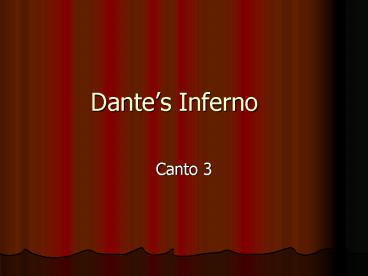Dante - PowerPoint PPT Presentation
Title:
Dante
Description:
Dante s Inferno Canto 3 Cowards,Neutrals This idea of a marginal place--inside the gate of hell but before the river Acheron--for souls neither good enough for ... – PowerPoint PPT presentation
Number of Views:145
Avg rating:3.0/5.0
Title: Dante
1
Dantes Inferno
- Canto 3
2
(No Transcript)
3
Cowards,Neutrals
- This idea of a marginal place--inside the gate of
hell but before the river Acheron--for souls
neither good enough for heaven nor evil enough
for hell proper is a product of Dante's
imagination, pure and simple. Included among
these cowardly souls--also known as
fence-sitters, wafflers, opportunists, and
neutrals--are the angels who refused to choose
between God and Lucifer. What does this original
idea say about Dante's view of human behavior and
its relation to the afterlife?
4
(No Transcript)
5
The great refusal
- From among the cowardly fence-sitters, Dante
singles out only the shade of one who made "the
great refusal" (Inf. 3.60). In fact, he says that
it was the sight of this one shade--unnamed yet
evidently well known--that confirmed for him the
nature of all the souls in this region. The most
likely candidate for this figure is Pope
Celestine V. His refusal to perform the duties
required of the pope (he abdicated five months
after his election in July 1294) allowed
Benedetto Caetani to become Pope Boniface VIII,
the man who proved to be Dante's most reviled
theological, political, and personal enemy. An
alternative candidate is Pontius Pilate, the
Roman governor who refused to pass judgment on
Jesus. Why does Dante refuse to name any of the
shades--including the notorious one--in this
particular region?
6
Abandon all hope
- It is not until the beginning of canto 3 that
Dante finally enters hell-- at least its outer
region--by passing through a gateway. The
inscription above this gate--ending with the
famous warning to "abandon all hope"--
establishes Dante's hell as a creation not of
evil and the devil but rather of his Christian
God, here expressed in terms of the Trinity
Father (Divine Power), Son (Highest Wisdom), and
Holy Spirit (Primal Love).
7
(No Transcript)
8
The Boatman
- In the classical underworld (Hades), which Dante
knew best from book 6 of Virgil's Aeneid, Charon
is the pilot of a boat that transports shades of
the dead--newly arrived from the world
above--across the waters into the lower world.
Like Virgil's Charon, Dante's ferryman is an old
man--with white hairs and fiery eyes-- who at
first objects to taking a living man on his boat.
In each case, the protagonist's guide-- Virgil
for Dante--provides the proper credentials for
gaining passage on Charon's boat.
9
(No Transcript)
10
The three rivers
- This is the first of the rivers and marshes of
Virgil's underworld in the Aeneid that Dante
includes in his topography of hell. Whereas
Virgil makes no clear distinction between the
locations and functions of these bodies of water
(Charon seems to guard them all), Dante's
infernal rivers are more sharply drawn. Here the
Acheron functions as a boundary separating the
cowardly neutrals from the souls in the circles
of hell proper. Charon ferries these shades
across the river. This attention to detail
reflects Dante's desire to underscore the reality
of hell and the protagonist's journey through it.































